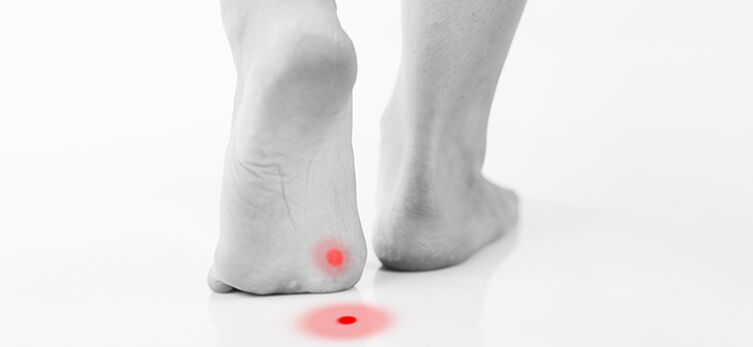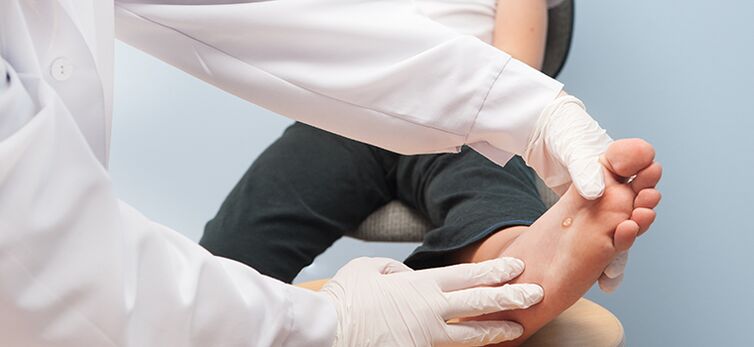plantar wart, or spike, looks like a hard-to-the-touch, flat formation on the skin of the foot that rises slightly above skin level. This type of wart refers to benign tumors of the epithelium, and diagnosis, as a rule, does not cause difficulties - the main method is dermatoscopy. The doctor visually determines the type of neoplasm using a special device. Warts can appear anywhere on the foot, but they usually form on the balls of the toes, heels, which are the areas of greatest pressure. The photo clearly shows what a plantar wart looks like, its appearance is quite specific and usually leaves no doubt about the diagnosis. The formation has a dirty brown or unpleasant yellow color, characteristic coarse papules are visible, destroying papillary patterns.

Since the formation is on the foot, it can cause pain and injury to the wart itself. For these reasons, the thorn needs to be treated, although there is a small chance that a plantar wart will go away on its own without serious treatment.
Unfortunately, getting rid of a wart is still not easy, so it is recommended to consult a dermatologist in order to reduce the risk of infecting other people and shorten the period of treatment of the disease. The use of exclusively folk remedies and independent attempts to get rid of the tumor are undesirable. The plantar wart has a deep root that is difficult to remove alone, so recurrences occur. Folk remedies often severely injure the surrounding tissues, which can lead to an increase in the area of \u200b\u200bthe damage and unpleasant consequences in the form of burns and scars.
symptoms
If you suspect a neoplasm, you should not only know what the plantar wart looks like in the photo, but also remember that the disease has characteristic symptoms:
- palpable itching at the site of origin;
- the size of the warts is from a few millimeters to 2 centimeters;
- Unlike corns, a wart causes pain;
- bleeding from injuries;
- pain when walking.
If you experience similar symptoms, contact your doctor immediately. It is easier to prevent an illness than to deal with the consequences.
Causes of a plantar wart
A plantar wart is caused by human papillomavirus (HPV) infection on the foot. The main transmission route is contact, infection occurs through shared objects or directly from person to person. A favorable environment is heat and humidity, so it is important to take precautions when visiting a bath, pool, sauna and gym.
Also, the cause of the occurrence can be a weakened immune system, since in the normal state the human papillomavirus does not show any visible manifestations.
Also, this type of warts can appear with microtrauma of the epidermis, dry skin, wearing tight uncomfortable shoes, hyperhidrosis. Also, the causes of a wart on the leg can be diseases that lead to foot deformity - arthritis of the joints, arthrosis, flat feet, as well as diseases that lead to a violation of the integrity of the skin of the feet: diabetes mellitus , varicose veins. It must be remembered that frequent stress can indirectly affect the occurrence of this disease.
HPV can be acquired accidentally by walking barefoot on an infected surface, the virus can survive for several months without a direct carrier. After entering the body, it may not manifest itself for several days or even weeks, which is why it is not always possible to know the exact time of infection.
diagnosis
To determine how to treat plantar warts, a dermatologist will conduct a number of studies:
- general inspection;
- dermoscopy;
- PCR diagnostics;
- histological examination.
How to cure plantar warts

When a plantar wart appears, the question arises as to how this new growth can be cured. If the growths cause excessive discomfort and spread quickly, it is best to contact a dermatologist as soon as possible, he will choose the most appropriate treatment option. There are several ways to solve this problem.
The most radical of them is operative: the wart and its roots are surgically removed. This method is not the most effective, since the roots of the neoplasm are located in the deep layers of the skin. In some cases it is not possible to remove them completely.
Removal of warts can be done with laser and electrocoagulation, as well as with cryotherapy.
In addition to removal in medical institutions, plantar warts can be removed using less radical methods, such as ointments, solutions, special plasters, as well as folk remedies. These means of removing plantar warts have a number of advantages and disadvantages, the main reason of which is the long treatment time.
Removal of plantar warts
One of the most common methods of removing plantar warts is removal at specialized medical institutions. The dermatologist at the appointment should tell you in detail how to get rid of plantar warts and, based on the results of the examination, choose the most appropriate method. Although the spines are difficult to cure, there are no special specific means to remove them, all methods relevant to the treatment of other types of warts are used. Plantar wart removal can be done on an outpatient basis, but your doctor can prescribe remedies to help you remove the growths at home.
Surgical removal of warts
Along with other treatment methods, surgery is used to remove warts. The wart is scraped out with a special scalpel under local anesthesia. After this procedure, if the plantar wart is significant, sutures are placed under the skin, which are removed within a week or two. The wound site is treated with a disinfectant solution and an aseptic bandage is applied. A small scar usually remains at the donor site.
The difficulty of this method is that during the operation the doctor must remove all the roots, otherwise the plantar wart will reappear. Therefore, this method is only used today when all other treatment methods have been ineffective.
Removal with liquid nitrogen
When removing with liquid nitrogen, the neoplasm is exposed to extremely low temperatures. This is the most common modern and fastest way to treat a plantar wart.
The procedure is based on freezing the formation tissue itself. In fact, inside the wart cells, under the influence of an extremely low temperature of -196 degrees Celsius, cracks appear, which leads to the death of the wart.
Cryodestruction is performed manually or by hardware. If the wart is large or the procedure is performed on a child, local anesthesia is required.
Exposure time directly to liquid nitrogen is up to 30 seconds. After the first cauterization, the doctor should pause to assess the effectiveness of the action and the need for re-cauterization.
After freezing, a blister with a colorless or reddish liquid is formed at the site of the wart, which indicates the beginning of the inflammatory process. This is a normal reaction to the cautery procedure.
Cryosurgery is considered painless, but when treating plantar warts, it needs to be repeated several times to achieve the final effect. After the wart falls off, no scars remain.
The advantages of liquid nitrogen removal are:
- Freezing prevents further spread of the disease to the nearest skin;
- lack of special education;
- short procedure time;
- The risks of developing scars or scars are minimal.
The disadvantages of cryodestruction of plantar warts are:
- the need for a second course with a large area of damage or because of the size of the wart;
- the human factor - the professionalism of the doctor who performs this procedure is a guarantee of success. The doctor must correctly assess the time and degree of nitrogen exposure to tissues, otherwise burns may occur.
- The discomfort that a swollen bladder brings and the need to process it are also considered disadvantages of the method.
In general, feedback on treating plantar warts with liquid nitrogen cautery is positive, as it is the simplest, most effective, and least expensive method.
laser removal
Laser removal is considered one of the most effective and safe methods. After the laser treatment, the wart is no longer contagious. The procedure itself is painless, a special nozzle is built into the laser, which cools the impact point. In addition, one or more anesthetic injections are administered before the operation. During the procedure, the patient usually feels a slight tingling sensation. After removal of the neoplasm, no traces remain, since the laser directly burns out the diseased tissue. The laser process allows maximum control of the depth of exposure, which is individual in each case. Therefore, even with deep tissue lesions, it is possible to completely remove the roots, which means that the wart will be prevented from growing again.
The operation takes place under sterile conditions, there is no direct skin or wart contact and the operation lasts only a few minutes. The positive results of plantar wart removal with a laser also make this method the most attractive.
The main disadvantage of laser plantar wart removal is the high cost, which usually includes a doctor's consultation, anesthesia, and the surgery itself. In addition, after removal, the wound heals for a long time and requires compliance with hygiene rules.
Treatment of plantar warts
Before treating a plantar wart, you need to make sure the diagnosis is correct and then proceed directly to the procedures. In addition to surgery, your doctor may prescribe immunotherapy and topical medications.
The need for immunotherapy is usually justified, since the disease is caused by a virus that is actively developing in a weakened state of the body. Topical immunotherapies directly affect the virus in two ways. In the first case, the drug stimulates the immune system, in the second, an antigen is injected into the body of the wart, which also activates the immune system so that the wart can disappear faster.
Treatment of a plantar wart takes quite a long time, it is important not to forget about strengthening the immune system and maintaining hygiene. If removal and treatment are not carried out, the wart can go away on its own for more than a year, while the person becomes a source of infection for everyone around him. You should carefully consider this unpleasant disease and be sure to contact a dermatologist, who will definitely tell you how and how to treat a plantar wart.
Treatment of a plantar wart directly depends on compliance with all hygiene standards and doctor's prescriptions, daily treatment of the formation is a guarantee of a successful recovery.
treatment at home
Any growths on the skin should not be ignored as cancer tension is increasing worldwide. Do not ignore the appointment with a specialist, he can prescribe treatment for a plantar wart at home. In this case, special solutions, ointments and a wart plaster are usually prescribed.
Ointments are one of the mildest methods of treatment, they act on the wart itself, due to which it gradually dies and disappears. In the treatment, the following types of ointments are used:
- antiviral ointment;
- acid-based ointment;
- various ointments based on herbal remedies.
Any type of ointment is spotted on the wart several times a day according to the instructions. When treating a plantar wart, before applying the drug, it must be steamed in warm water beforehand. It is advisable to apply any ointment at night so that you do not step on the formation and have to wash off the ointment.
To get rid of plantar warts at home, you can use a special patch based on salicylic acid. This tool is inexpensive and has proven to be effective. The patch is sold in pharmacies without a prescription, the principle of its use is very simple - a wart is sealed with a piece of plaster, and an ordinary medical patch is attached to it. You must change the patch at regular intervals. It can take about two weeks to remove a small wart, and you shouldn't leave the wart without a bandage for long. As the treatment progresses, the area of the wart decreases, after 12 hours it becomes covered with a crust, which then disappears. After successful treatment, a small pink spot will remain on the skin, which should disappear completely over time.
Care should be taken when sticking the patch on - healthy skin areas should be avoided when applying, otherwise severe irritation may occur. There are contraindications to using this method of removing the wart, so the decision to prescribe the patch should be taken by the doctor.
Another way to treat plantar warts at home is hyperthermia. Feet affected by warts are immersed in water that is as hot as possible. Such procedures are repeated several times. In some cases, hyperthermia shows a positive effect. The mechanism of the procedure is based on the stimulation of small blood vessels in the legs and activation of local immunity.
At home, you can use low temperature treatment by analogy with removing warts with liquid nitrogen. To do this, you can use special pen applicators or sprays. As with cryosurgery, multiple applications may be required.
Treatment with folk remedies
Despite the fact that modern drugs are much more effective and with their help the process of removing plantar warts is faster, the effectiveness of treatment with folk remedies cannot be denied. Traditional medicine has gained a lot of experience in the fight against warts, and some methods remain effective.
- Celandine juice is one of the most popular ways to remove thorns. You can use the juice of a fresh plant or buy a drug at the pharmacy that, in addition to celandine juice, contains other herbal extracts. The juice is applied to the affected area once or twice a day.
- Acetic acid is also used to remove warts along with various additive products. In addition to acid, onions and flour are used. You can drip onto the affected area directly and the acid itself, but this method is quite dangerous due to the high risk of severe burns.
- Apple cider vinegar: A swab soaked with a solution (it is important not to use undiluted vinegar) is applied to the affected area of the skin, the area of \u200b\u200bthe skin is pre-treated with an abrasive nail file.
- Garlic is another folk remedy used to treat warts. Raw garlic should be rubbed on the formation until it completely disappears, but this method can be used no more than three weeks.
- The banana peel is applied to the affected area of skin inside out, it is believed to stretch the wart.
In order to puncture the site of the lesion and not affect the adjacent tissues, you can use a piece of tape. Depending on the size of the neoplasm, a hole is made in it, and the adjacent healthy skin is left intact. This will prevent burns and other injuries.
Plantar wart in a child
With age, a person develops immunity to HPV, so children and adolescents are more susceptible to this infection. Most often, the disease affects children over the age of five. A doctor will help identify a plantar wart in a child, as in some cases it can resemble an old corn.
Although plantar warts in a child go away on their own, their treatment should not be ignored, it is also worth remembering the possibility of infecting the whole family and those around them. A plantar wart in a child almost always causes severe painful discomfort when walking, so it requires immediate treatment and a visit to the doctor.
Since children are sensitive to pain, it is quite difficult to find a therapy. First of all, it is worth using various ointments - they are affordable, convenient to use and effective. Folk remedies are also widespread, and there can be no doubt about their safety.
Effective methods of removing plantar warts in children are liquid nitrogen and laser removal. Removing warts using these methods is one of the most radical methods. They are resorted to when solutions and ointments do not give the desired effect.
After treatment, it is important not to forget about the prevention of plantar warts in children. This includes strengthening the immune system, careful hygiene and wearing the right comfortable shoes. It should be noted that the risk of infection is particularly high in public places and through another person. You must therefore ensure that the child does not walk in someone else's shoes or walk barefoot. Anything that has come into direct contact with the formation must be thoroughly washed at a high temperature. All these measures will help prevent the virus from developing in the future.
danger
If the procedure for removing plantar warts is not carried out in a timely manner, there can be serious consequences, such as:
- the appearance of warts on other areas of the skin;
- skin cancer.
Doctors strongly do not recommend self-medication - cutting, pricking or cauterizing warts aggravates the situation and leads to the formation of new warts.
risk group
The risk group is:
- people with hormonal disorders in the body;
- HIV infected.
prevention

To prevent plantar warts, patients are advised to:
- strengthening immunity;
- eat more foods rich in vitamins;
- properly care for the skin of the feet;
- do not wear tight shoes, shoes made of synthetic materials;
- do not go barefoot in public places (changing rooms, showers).

















